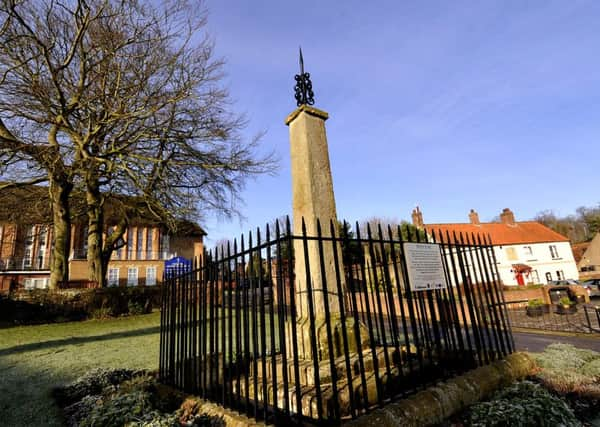Your Day Out: Highlights of historic Hunmanby


Behind is the modern Methodist Church, and close by you’ll see Hunmanby Hall, built in the early 18th century by a member of the Osbaldeston family. Set in the midst of extensive grounds, it was their home for 200 years. In 1927 the hall became a girls’ boarding school, and in 1978 celebrated its golden jubilee. In 1991 the school closed, and later was converted into apartments.
From the market place, admire old houses and cottages. Osgodby House and Denmark House bear crests denoting former estate ownership. Across the road is Admiral’s Arch, erected to the memory of Admiral Mitford, who died in 1870.
Advertisement
Hide AdAdvertisement
Hide AdChurch Walk is an ancient pathway that once traversed the churchyard. It goes alongside the grounds of Wrangham House on the right. This used to be the old vicarage. One famous account was Archdeacon Francis Wrangham, the vicar (1795-1840), who added a new wing to the house in 1803 to accommodate his extensive library. He would travel all over England, buying books at whatever the cost, and stacking them in every room until he added the extension! He died in 1842. His library was sold by auction at a sale lasting three weeks. Wrangham House then became a private hotel.
Returning to Admiral Arch, a very imposing lychgate to the right leads to the churchyard. The stone archway was adorned with tracery and a shield, set up in memory of Admiral Mitford - benefactor of the village.
The parish church of All Saints is built on elevated ground. It overlooks Cross Hill and the attractive frontage of the White Swan Inn. This inn was a well-known hostelry in coaching days.
Much of the church was built by the Norman Overlord, Gilbert de Gant. He also erected the castle and bailey, which were surrounded by a dry moat - now the roadway of Church Hill.
Advertisement
Hide AdAdvertisement
Hide AdReaching Northgate, to the right, Castle House Farm was one of the village’s older farm houses.
The village streets are pleasantly wide, with many old white-washed cottages. Over one doorway is the date 1694. On Stonegate is a row of chalk cottages, typical of old Hunmanby despite a few alterations.
Continuing past Bowling Green Lane you must cross the road to Pinfold Green. Anyone will direct you there, as one’s attention is focused on the pinfold. In springtime it’s gay with daffodils.
The pinfold is built of cobles from the sea-shore. Here would be impounded any straying cattle or other livestock. They were returned to the owner only after the paying of a fine.
Advertisement
Hide AdAdvertisement
Hide AdAdjacent to the pinfold is the lockup, dated 1834. It was sometimes known as the Black Hole. It was used most frequently at annual fairs and Martinmas, following disorderly scenes. It has separate cells for men and women offenders.
Just beyond, Low Hall was the home of the Raylor family for 60 years. Mr William Raylor died in 1956 at the age of 92. He was bandmaster for 68 years - a proud achievement indeed. Hunmanby village band existed before 1880, I’m told!
After the 1914 war, Sir Dennis Bayley supplied new instruments and uniforms for The Dennis Bayley Hunmanby Silver Band. In 1921, uniting with Hunmanby Brass Band, led by Mr Fred Lawty, they were in popular demand. The big event of the year was the fancy dress dance and whist drive. Prizes included whole hams and quarter tons of coal, all for an admission of half a crown (12½p).
Bridlington Street with its fine array of shops attracts many tourists and yet manages to retain its unique charm.
Advertisement
Hide AdAdvertisement
Hide AdOne of the village highlights was to celebrate the Festival of Britain in June 1951. Hunmanby’s history was unfolded when 200 children from the county primary school took part in a special pageant, re-living by-gone days. The entire pageant was in mime. A loud-speaker commentary was given by the headmaster, Mr JM Danby.
Doris Bulmer received a thank you letter from Mr Danby for her “working wonders of creation and improvisation,” in her preparation of costumes for the pageant.
Miss Lucy Owston devoted her life to the community, being involved in no fewer than 10 local positions, clubs and institutes. She died aged 93, and her funeral was attended by about 250 mourners. It was a great tribute to a wonderful lady.
[Finally, in 1907 the grave of a British charioteer was discovered. With his bones were those of his horses, fragments of the chariot wheels, and a piece of metal probably fixed at the front, and used as a mirror for a rear view.]
Refreshment: Plenty of cafes, inns and shops.
Transport: East Yorkshire bus service, 121.